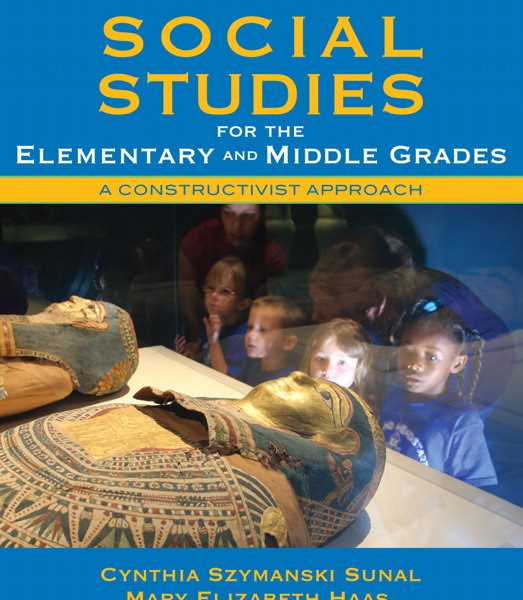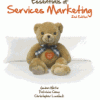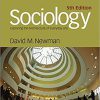Test Bank For Social Studies for the Elementary and Middle Grades: A Constructivist Approach, 4/E 4th Edition
$35.00 Original price was: $35.00.$26.50Current price is: $26.50.
Test Bank For Social Studies for the Elementary and Middle Grades: A Constructivist Approach, 4/E 4th Edition
Instant download Test Bank For Social Studies for the Elementary and Middle Grades: A Constructivist Approach, 4/E 4th Edition pdf docx epub after payment.

Product details:
- ISBN-10 : 0137048858
- ISBN-13 : 978-0137048854
- Author: Cynthia Szymanski Sunal (Author), Mary Elizabeth Haas (Author)
Building on the success of previous editions, Social Studies for the Elementary and Middle Grades discusses flexible strategies for teaching today’s diverse learner, the structure of the knowledge to be learned, how to help students reconstruct present ideas, and how to translate theory and recent research into lesson plans and units.
Packed with activities, up-to-date technology, teaching strategies, and a constructivist approach, this text demonstrates how to use developmentally appropriate strategies to help students construct important social studies ideas and skills.
Table of contents:
Normal 0 false false false MicrosoftInternetExplorer4 Chapter 1: What is Powerful and Meaningful Social Studies?
Exploratory Introduction
Chapter Overview
Chapter Objectives
Development: Social Studies in the Elementary and Middle School
A First-Grade Classroom Scene
A Sixth-Grade Classroom Scene
Time for Reflection: What Do You Think?
What Is Purposeful and Powerful Social Studies?
Building on Diversity Box: Meaningful Social Studies
Defining Social Studies
Education for Active Citizenship
Using Technology Box: Deciding Whether and When
Social Studies Curriculum
Planning Powerful Social Studies Lessons
Learning Cycle Lesson Plan: From Tree to Paper
Time for Reflection: What Do You Think?
Making a Literature Connection Box: Using Trade Books in Social Studies
Social Studies is Essential
Expansion:
Summary
Recommended Websites to Visit
Chapter 2: How Do Students Engage in Powerful and Meaningful Social Studies?
Exploratory Introduction
Chapter Overview
Chapter Objectives
How is Social Studies Best Taught in Today’s Classrooms?
Development: Applying What We Know About Meaningful Learning to Social Studies Curriculum
Using Constructivist Theory in Social Studies Instruction
Using Behavioral Learning Theory in Social Studies Instruction
An Effective Strategy to Promote Conceptual Change
Phases of a Learning Cycle Lesson
Learning Cycle Lesson Plan: Scale
Time for Reflection: What Do You Think?
Exploratory Introduction
Development
Expansion
Lesson Summary
Choosing Activities for Each Phase of the Learning Cycle Lesson
Time for Reflection: What Do You Think?
Building on Diversity Box
Student Assessment in Each Phase of the Learning Cycle
Writing Your Own Learning Cycle Lesson
The Optimal Length of Time for a Learning Cycle
Working With the Learning Cycle
Expansion: Principles of Teaching and Learning that Support the Curriculum Standards for the Social Studies
Time for Reflection: What Do You Think?
Summary
Recommended Websites to Visit
Chapter 3: How Are Students Social Studies Inquiry Skills Learned?
Exploratory Introduction
Chapter Overview
Chapter Objectives
Development: Using Inquiry Skills to Develop Students’ Social Studies Ideas
Early Inquiry Skills
Social Studies Inquiry Skills
Data-Gathering Skills
Data-Organizing Skills
Data-Processing Skills
Communicating Skills
Reflecting Skills
Time for Reflection: What Do You Think?
Using Technology Box
Time for Reflection: What Do You Think?
Observations, Inferences, and Hypotheses
Observations
Inferences
Hypotheses
Developing and Using Guiding Hypotheses
Time for Reflection: What Do You Think?
Teaching Lessons in Which Students Use Integrative Thinking Skills
Critical Thinking
Problem Solving and Decision Making
Investigating
Creative Thinking
Time for Reflection: What Do You Think?
Creating Conditions that Promote Student Thinking in Social Studies
Lesson Characteristics
Planning Activities to Teach Inquiry Skills
Expansion: Applying a Learning Cycle to Teach an Inquiry Skill
Learning Cycle Lesson Plan: How Can We Classify Native American Food Plants?
Time for Reflection: What Do You Think?
Assessing the Use of Inquiry Skills
Hierarchy of Inquiry Skills
Classroom Scenario: The Mystery in the Back Yard
Time for Reflection: What Do You Think?
Summary
Recommended Websites to Visit
Chapter 4: How Are Social Studies Concepts and Generalizations Developed?
Exploratory Introduction
Chapter Overview
Chapter Objectives
Concept Teaching Starts with Reflection and Practice
A Fourth-Grade Classroom Scene
Development: Facts as Social Studies Concepts
Classroom Scenario: Constructing a Concept of Aggression
Forming Concepts
Identifying All Important Attributes of a concept
Time for Reflection: What Do You Think?
Types of Concepts
Time for Reflection: What Do You Think?
Interrelationships Among Concepts
Time for Reflection: What Do You Think?
Differences in Complexity and Abstractness of Concepts
Time for Reflection: What Do You Think?
Powerful Concept Teaching
The Concept Learning Cycle
Teaching Concepts of Varying Complexity and Abstractness Differently
Building on Diversity Box
Learning Cycle Lesson Plan: Productive Resources
Time for Reflection: What Do You Think?
Assessment of Concept Learning
Using Technology Box
Generalizations Show Relationships Between Concepts
Forming Generalizations
Defining Generalizations
Distinguishing Generalizations from Facts and Concepts
Using Generalizations to Make Predictions
Making a Literature Connection Box
Types of Generalizations
Teaching Powerful Generalizations
Time for Reflection: What Do You Think?
The Exploratory Introduction Phase of a Generalization Learning Cycle
The Lesson Development Phase of a Generalization Learning Cycle
The Expansion Phase of a Generalization Learning Cycle
Learning Cycle Lesson Plan: Using Technology to Investigate a Problem: Why Are Cities Built Where Rivers Come Together?
Formative Evaluation and Assessment In Constructing Generalizations
Expansion: Applying Concepts and Generalizations to Create Powerful and Meaningful Social Studies
Summary
Recommended Websites to Visit
Chapter 5: How Do Students Develop Citizenship in Democratic and Global Societies?
Exploratory Introduction
Chapter Overview
Chapter Objectives
Development: Defining Citizenship in a Democratic Society
Developing Political Awareness
Time for Reflection: What Do You Think?
Citizenship and Standards
Key Concepts and Values
Learning Cycle Lesson Plan: Voting is a Way to Make Decisions
Time for Reflection: What Do You Think?
Assessing Civic Education in U. S. Schools
Resources for Citizenship Education
Media Resources
Making a Literature Connection: Selecting a Trade Book That Stresses Social Studies
Law-Related Education
Learning Cycle Lesson Plan: Presidential Oath
Time for Reflection: What Do You Think?
Participating in Democracy
Time for Reflection: What Do You Think?
School-Based Community Service Projects
Participation in Student Government
Building on Diversity box: The Challenges
Using Technology box: Cybercitizenship
Political Participation
Time for Reflection: What Do You Think?
Expansion
Summary
Recommended Websites to Visit
Chapter 6: What is Social Studies’ Contribution to Global Education?
Exploratory Introduction
Chapter Overview
Chapter Objectives
Development: Global Education: An Evolving Definition
Global Education Appropriate for Grades Kindergarten – 8
Approaches to Global Education
Building on Diversity box: Finding the Views of People in Other Nations
The Cultural Approach to Global Education
Global Education Appropriate for K-8
The Problems Approach to Global Education
Time for Reflection: What Do You Think?
Interdisciplinary Connections
Teaching Global Education
Resources for Teaching Global Education
Computers and the Internet
Learning Cycle Unit Plan: Teaching About War to Help Create a More Humane World
Time for Reflection: What Do You Think?
Book Series
Resources for Current Events
Expansion
Summary
Recommended Websites to Visit
Chapter 7: How Do Teachers Use and Manage Social Studies Instructional Strategies Effectively?
Exploratory Introduction
Chapter Overview
Chapter Objectives
Development: Social Studies Pedagogical content Knowledge (PCK)
Teaching Dimensions That Support Meaningful Learning
Clarity
Variety
Task Orientation
Student Engagement
Best Practices: Teaching Strategies that Support Meaningful Learning
Questioning
Cooperative Learning
Using Technology box: Creating a Collaborative Classroom
A Continuum of Knowledge and Instruction
Matching Instructional Strategies to Student Needs
Expository, or Direct, Instructional Methods: Lower Student Control
Guided Discovery Instructional Methods: Mixed Teacher and Student Control
Inquiry and Problem-Solving/Decision-Making Instructional Methods: Greater Student Control
Matching Types of Instructional Activities to Each Phase of the Lesson
A Classroom Scene: One Teacher’s Planning Decisions
Time for Reflection: What Do You Think?
Useful Instructional Activities for the Exploratory Introduction Phase
Cooperative Group Challenge
Confrontational Challenges or Discrepant Events
Problem Exploration
Open Exploration
Useful Instructional Activities for the Lesson Development Phase
Field Trips
Guest Speakers
Demonstration
Lecture or Teacher Presentation
Games
Role-Playing and Simulations
Role-Playing
Simulations
Writing in Social Studies
Difficulties In Reading Textbooks
Doing a Content Analysis of a Textbook
Developing a Teaching Plan Using a Textbook
Time for Reflection: What Do You Think?
Social Studies Kits
Making a Literature Connection Box: Reading Literature
Building on Diversity Box: Reading Activities
Visual Information and Literacy
Learning Centers
Inquiry Invitation
Using a WebQuest
Useful Instructional Activities for the Expansion Phase
Classroom Management Strategies for Powerful Social Studies
Advanced Planning
Giving Directions
Distributing Materials
Organizing the Beginning
Grouping Students
Using Classroom Rules
Crating Lesson Smoothness
Being a Facilitator
Assessment Considerations
Expansion: Making Decisions About Which Instructional Strategies to Use
Summary
Recommended Websites to Visit
Chapter 8: How Are Powerful and Meaningful Social Studies Units Constructed?
Exploratory Introduction
Chapter Overview
Chapter Objectives
Development: Planning the Appropriate Focus for Social Studies Units
Thinking-Skills Focused Units
Conceptual and Thinking Skills-Focused Units
Units that Integrate School Subjects
Theme Units
Issue and Problem-Solving Units
Time for Reflection: What Do You Think
How to Choose Appropriate Topics for Integrated Units
Planning Integrated Units
Using a Column Design
Developing Integrated Units
Step 1: Generating Ideas for the Topic of a Unit
Step 2: Researching the Topic
Step 3: Developing Essential or Focus Questions
Step 4: Identifying Special Needs Among Students and Making Accommodations
Step 5: Developing Intended Learning Outcomes
Step 6: Categorizing Intended Learning Outcomes
Step 7: Creating an Idea Web
Step 8: Developing a Rationale and goals
Step 9: Beginning the KWL Chart
Step 10: Developing Learning Objectives
Step 11: Developing an Assessment Plan
Time for Reflection: What Do You Think?
Step 12: Developing Lesson Plans
Step 13: Developing Accommodations for Technology
Making a Literature Connection Box: Incorporating Social Studies Trade Books into Units
Step 14: Implementing the Unit
Step 15: Evaluating Student Learning
Step 16: Reflecting on the Unit
Using Technology Box: Databases and Spreadsheets
Expansion: Conceptualizing an Integrated Unit
Time for Reflection: What Do You Think?
Summary
Recommended Websites to Visit
Chapter 9: How Do Teachers Foster Students’ Development as Individuals and Community Members?
Exploratory Introduction
Chapter Overview
Chapter Objectives
Development: Respect for Diverse Students and Oneself as a Teacher
Learning Cycle Lesson Plan: Sharing and Negotiation
The Curriculum Respects Diversity
Time for Reflection: What Do You Think?
Development of Self-Concept in Diverse Students
Independence and Responsibility
Jealousy
Fears
Aggressive Feelings, Bullying, and Conflict Resolution
Using Technology Box: Internet Safety and Cyber-Bullying
Friendship
Empathy and Helpful Prosocial Behaviors
Self-Esteem
Values and Moral Education in a Diverse Society
Building on Diversity Box: Learning from the Voices of Our Family and Community
Three Aspects of Morality
Moral Development Theories
Teaching Approaches for Values Education
Character Education
Attitudes and Dispositions Promoting Powerful Social Studies
Curiosity
Respect for Evidence
Open-Mindedness
Perseverance
Consideration of Conflicting Evidence
Reserving Judgment
Flexibility
Responsibility to Others and to the Environment
Values, Morals, and Aesthetics
Making a Literature Connection Box: Demonstrating Powerful Attitudes and Dispositions
Assessing How Diverse Students Relate to Individuals and Communities
Time for Reflection: What Do You Think?
Expansion: Confronting Challenges to Students’ Active, Responsible Development at Citizens
Time for Reflection: What Do You Think?
Summary
Recommended Websites to Visit
Chapter 10: How Can I Involve All Students in Meaningful Social Studies?
Exploratory Introduction
Chapter Overview
Chapter Objectives
Development: Meaningful Social Studies for All Students
“Best Practices”: Giving All Students Greater Control of Their Social Studies Learning
Social Studies Education for Students with Disabilities
General Instructional Strategies for Inclusive Classrooms
Using Technology Box
Multisensory Activities.
Cooperative Group Activities.
Classwide Peer Tutoring.
Peer Buddy System.
Reciprocal Teaching.
Reading Alone.
Lecture-Based Presentation.
Media Presentations.
Strategies for Using Social Studies Textbooks.
Study Guides.
General Suggestions for Adapting Textbook Materials for a Diverse Classroom.
Factors to be Considered in Adapting Social Studies Curricula and Instruction
Involving Students with Visual or Hearing Impairments
Social Studies Education in a Culturally Diverse Society
Time for Reflection: What Do You Think?
Building on Diversity Box
Culturally Responsive Teaching
Sample Strategies for Multicultural Social Studies
Historical Approach
Current Social Issues
Using Student Culture
Role Models and Relevancy
Role Models
Making a Literature Connection Box
Culture and Gender Differences in Student-Teacher Interactions
Helping English Language Learners Participate in Social Studies
Recognizing and Scaffolding Language Learning
Instructional Strategies for Helping ELL Students Understand Social Studies Content
Assessment of Social Studies Learning for All Students
Group Assessment Through Cooperative Learning
Graphic Organizers
Oral Interviews
Projects
Portfolios
Journal Writing
Expansion: Applying Ideas for Helping All Students Learn Meaningful Social Studies
Time for Reflection: What Do You Think?
Summary
Recommended Websites to Visit
Chapter 11: How Do I Engage Students in Examining History?
Exploratory Introduction
Chapter Overview
Chapter Objectives
Development: Definition of History
History in Schools
Learning Cycle Lesson Plan: Learning from the Paintings and Drawings of Artists
Time for Reflection: What Do You Think?
Standards for History
Benefits of Studying History
Students and the Learning of History
Using Timelines to Develop Chronology
Resources for Teaching History
Locating and Using Historical Resources
People as Resources
Artifacts and Museums
The Community as a Resource
Documents as Resources
Diaries, Letters, and Pictures as Resources
Visual Literacy and History
Reenactments and Drama
Time for Reflection: What Do You Think?
Biographies and Historical Literature
Building on Diversity: Pitfalls in Selecting Multicultural Books
Making a Literature Connection: Using Trade Books to Add Depth to History Units
Using Technology: Using Interactive Activities and Games in Learning History
Expansion: Your Skills in History
The Lincoln Penny Worksheet
Time for Reflection: What Do You Think?
Summary
Recommended Websites to Visit
People also search:
Social Studies for the Elementary and Middle Grades: A Constructivist Approach, 4/E 4th Edition
Social Studies for the Elementary and Middle Grades: A Constructivist Approach, 4/E 4th Edition pdf
Social Studies for the Elementary and Middle Grades: A Constructivist Approach
Related products
Test Bank
Test Bank for Decision Support and Business Intelligence Systems, 9th Edition: Efraim Turban











